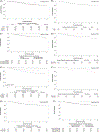A comprehensive analysis of neuroblastoma incidence, survival, and racial and ethnic disparities from 2001 to 2019
- PMID: 37867409
- PMCID: PMC11018254
- DOI: 10.1002/pbc.30732
A comprehensive analysis of neuroblastoma incidence, survival, and racial and ethnic disparities from 2001 to 2019
Abstract
Background: We characterize the incidence and 5-year survival of children and adolescents with neuroblastoma stratified by demographic and clinical factors based on the comprehensive data from United States Cancer Statistics (USCS) and the National Program of Cancer Registries (NPCR).
Methods: We analyzed the incidence of neuroblastoma from USCS (2003-2019) and survival data from NPCR (2001-2018) for patients less than 20 years old. Incidence trends were calculated by average annual percent change (AAPC) using joinpoint regression. Differences in relative survival were estimated comparing non-overlapping confidence intervals (CI).
Results: We identified 11,543 primary neuroblastoma cases in USCS. Age-adjusted incidence was 8.3 per million persons [95% CI: 8.2, 8.5], with an AAPC of 0.4% [95% CI: -0.1, 0.9]. Five-year relative survival from the NPCR dataset (n = 10,676) was 79.7% [95% CI: 78.9, 80.5]. Patients aged less than 1 year had the highest 5-year relative survival (92.5%). Five-year relative survival was higher for non-Hispanic White patients (80.7%) or Hispanic patients (80.8%) compared to non-Hispanic Black patients (72.6%).
Conclusion: Neuroblastoma incidence was stable during 2003-2019. Differences in relative survival exist by sex, age, race/ethnicity, and stage; patients who were male, older, non-Hispanic Black, or with distant disease had worse survival. Future studies could seek to assess the upstream factors driving disparities in survival, and evaluate interventions to address inequities and improve survival across all groups.
Keywords: epidemiology; neuroblastoma; outcomes research.
© 2023 Wiley Periodicals LLC.
Conflict of interest statement
CONFLICT OF INTEREST STATEMENT
The authors declare they have no conflicts of interest. The findings and conclusions in this report are those of the authors and do not necessarily represent the official position of the Centers for Disease Control and Prevention.
Figures


References
-
- NIH. Surveillance, epidemiology, and end results (SEER) program SEER*stat database: incidence-SEER 9 regs research data. National Cancer Institute, Surveillance Research Program; 2021.
MeSH terms
Grants and funding
LinkOut - more resources
Full Text Sources
Medical

